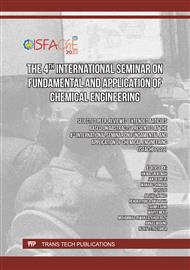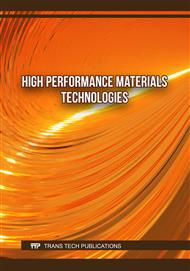[1]
Y. Lai et al., "Insight into heat generation of lithium ion batteries based on the electrochemical-thermal model at high discharge rates," Int. J. Hydrogen Energy, vol. 40, no. 38, p.13039–13049, 2015.
DOI: 10.1016/j.ijhydene.2015.07.079
Google Scholar
[2]
M. N. Yuniarto, I. Sidharta, S. E. Wiratno, Y. U. Nugraha, and D. A. Asfani, "Indonesian Electric Motorcycle Development: Lessons from innovation-based concept implementation on the design and production of the first Indonesian electric motorcycle," IEEE Electrif. Mag., vol. 10, no. 1, p.65–74, 2022.
DOI: 10.1109/MELE.2021.3139247
Google Scholar
[3]
L. H. Saw, Y. Ye, and A. A. O. Tay, "Electrochemical–thermal analysis of 18650 Lithium Iron Phosphate cell," Energy Convers. Manag., vol. 75, p.162–174, 2013.
DOI: 10.1016/j.enconman.2013.05.040
Google Scholar
[4]
J. Lin, X. Liu, S. Li, C. Zhang, and S. Yang, "A review on recent progress, challenges and perspective of battery thermal management system," Int. J. Heat Mass Transf., vol. 167, p.120834, 2021.
DOI: 10.1016/j.ijheatmasstransfer.2020.120834
Google Scholar
[5]
H. Pang, L.-J. Mou, and L. Guo, "Parameter identification and SOC estimation approach for an enhanced lithium-ion battery equivalent circuit model considering the influence of ambient temperatures," Chinese Phys. B, vol. 28, Aug. 2019.
DOI: 10.1088/1674-1056/ab3af5
Google Scholar
[6]
A. R. Sharma, C. S. Sai, A. Kumar, R. V. Jayasimha Reddy, D. Danyharsha, and R. Jilte, "Three-dimensional CFD study on heat dissipation in cylindrical lithium-ion battery module," Mater. Today Proc., vol. 46, p.10964–10968, 2021.
DOI: 10.1016/j.matpr.2021.02.041
Google Scholar
[7]
M. Malik, K. H. Chan, and G. Azimi, "Review on the synthesis of LiNixMnyCo1-x-yO2 (NMC) cathodes for lithium-ion batteries," Mater. Today Energy, vol. 28, p.101066, 2022.
DOI: 10.1016/j.mtener.2022.101066
Google Scholar
[8]
S. Käbitz et al., "Cycle and calendar life study of a graphite|LiNi1/3Mn1/3Co1/3O2 Li-ion high energy system. Part A: Full cell characterization," J. Power Sources, vol. 239, p.572–583, 2013.
DOI: 10.1016/j.jpowsour.2013.03.045
Google Scholar
[9]
K. Jalkanen, J. Karppinen, L. Skogström, T. Laurila, M. Nisula, and K. Vuorilehto, "Cycle aging of commercial NMC/graphite pouch cells at different temperatures," Appl. Energy, vol. 154, p.160–172, 2015.
DOI: 10.1016/j.apenergy.2015.04.110
Google Scholar
[10]
F. Richter, P. J. S. Vie, S. Kjelstrup, and O. S. Burheim, "Measurements of ageing and thermal conductivity in a secondary NMC-hard carbon Li-ion battery and the impact on internal temperature profiles," Electrochim. Acta, vol. 250, p.228–237, 2017.
DOI: 10.1016/j.electacta.2017.07.173
Google Scholar
[11]
S. Jenu, I. Deviatkin, A. Hentunen, M. Myllysilta, S. Viik, and M. Pihlatie, "Reducing the climate change impacts of lithium-ion batteries by their cautious management through integration of stress factors and life cycle assessment," J. Energy Storage, vol. 27, p.101023, 2020.
DOI: 10.1016/j.est.2019.101023
Google Scholar
[12]
Z. Xu, G. Yu, T. Zhang, and R. Wang, "Cooling performance of battery pack as affected by inlet position and inlet air velocity in electric vehicle," Case Stud. Therm. Eng., vol. 39, p.102382, 2022.
DOI: 10.1016/j.csite.2022.102382
Google Scholar
[13]
P. G. Zadeh, E. Gholamalizadeh, Y. Wang, and J. D. Chung, "Electrochemical modeling of a thermal management system for cylindrical lithium-ion battery pack considering battery capacity fade," Case Stud. Therm. Eng., vol. 32, p.101878, 2022.
DOI: 10.1016/j.csite.2022.101878
Google Scholar
[14]
F. Li, M. Ibrahim, T. Saeed, A. M. El-Refaey, M. A. Fagiry, and B. A. Elkhader, "Numerical simulation of air outlet spacing change in thermal management lithium-ion battery pack with triangular arrangement for use in electric vehicles," J. Energy Storage, vol. 49, p.104117, 2022.
DOI: 10.1016/j.est.2022.104117
Google Scholar
[15]
W. Yang, F. Zhou, X. Chen, K. Li, and J. Shen, "Thermal performance of honeycomb-type cylindrical lithium-ion battery pack with air distribution plate and bionic heat sinks," Appl. Therm. Eng., vol. 218, p.119299, 2023.
DOI: 10.1016/j.applthermaleng.2022.119299
Google Scholar
[16]
Tete, P. R., Gupta, M. M., & Joshi, S. S. (2022). Numerical Investigation on Thermal Characteristics of a Liquid-Cooled Lithium-Ion Battery Pack with Cylindrical Cell Casings and a Square Duct. Journal of Energy Storage, 1-17.
DOI: 10.1016/j.est.2022.104041
Google Scholar



